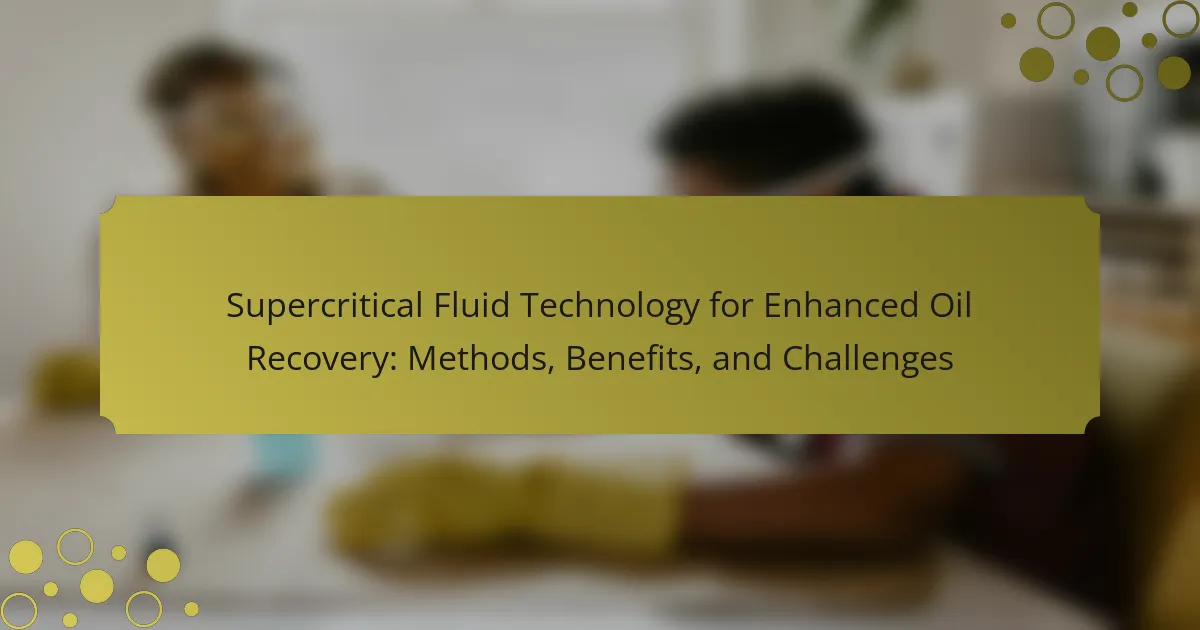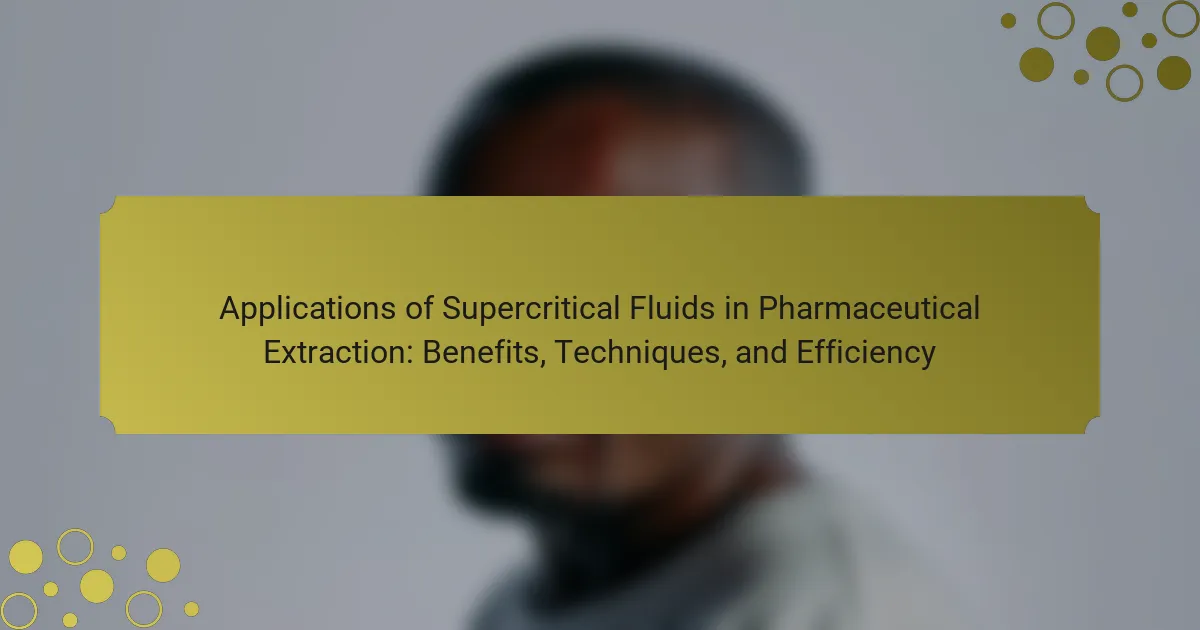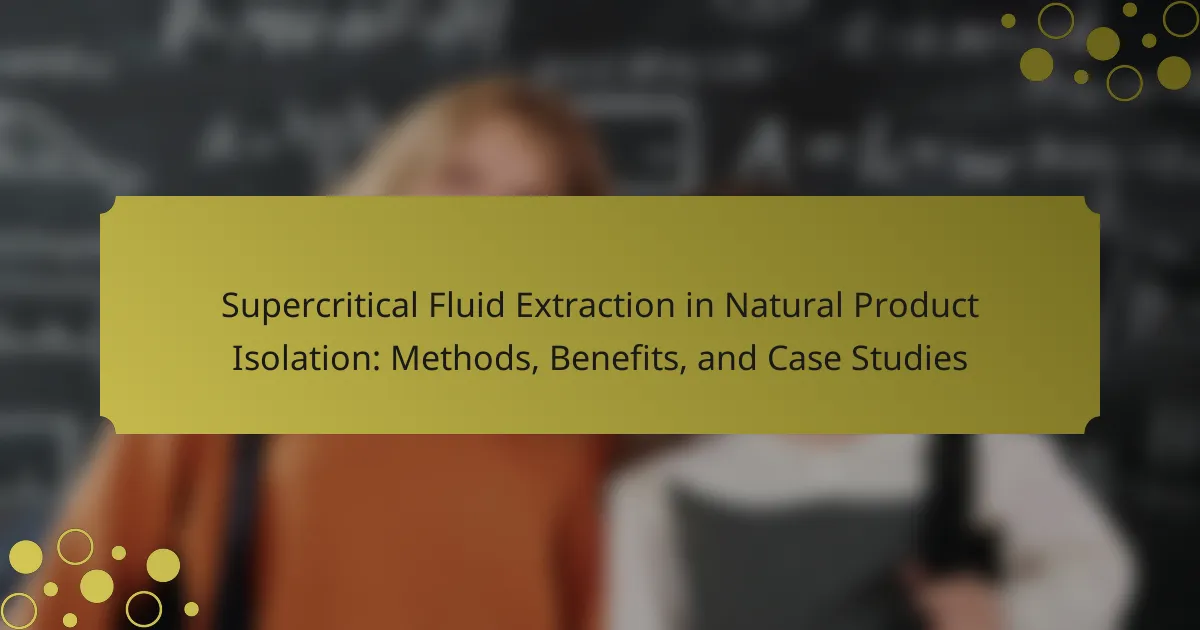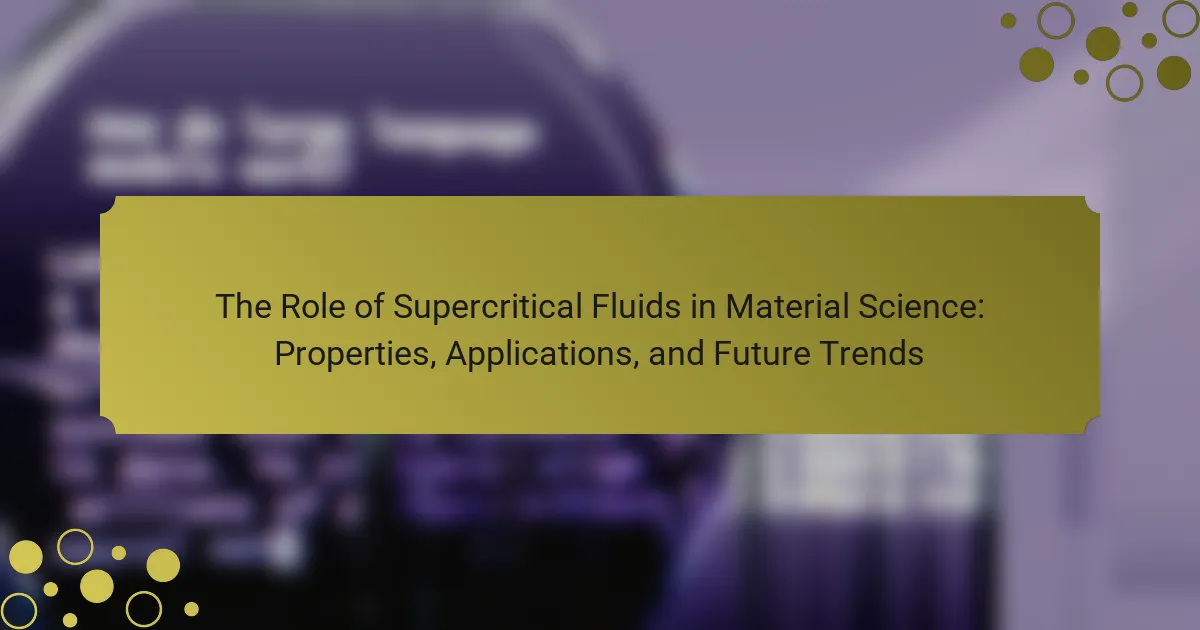Supercritical Water Oxidation (SCWO) is a waste treatment technology that employs supercritical water as a solvent to oxidize organic materials. Operating at temperatures above 374°C and pressures around 22 MPa, SCWO facilitates efficient reactions, leading to the complete mineralization of waste into carbon dioxide, water, and inorganic residues. This process is particularly effective for a variety of waste types, including hazardous and industrial waste, achieving destruction efficiencies often exceeding 99%. The article explores the mechanisms of SCWO, including the role of temperature, pressure, and oxidizing agents, as well as its applications in treating complex waste streams.
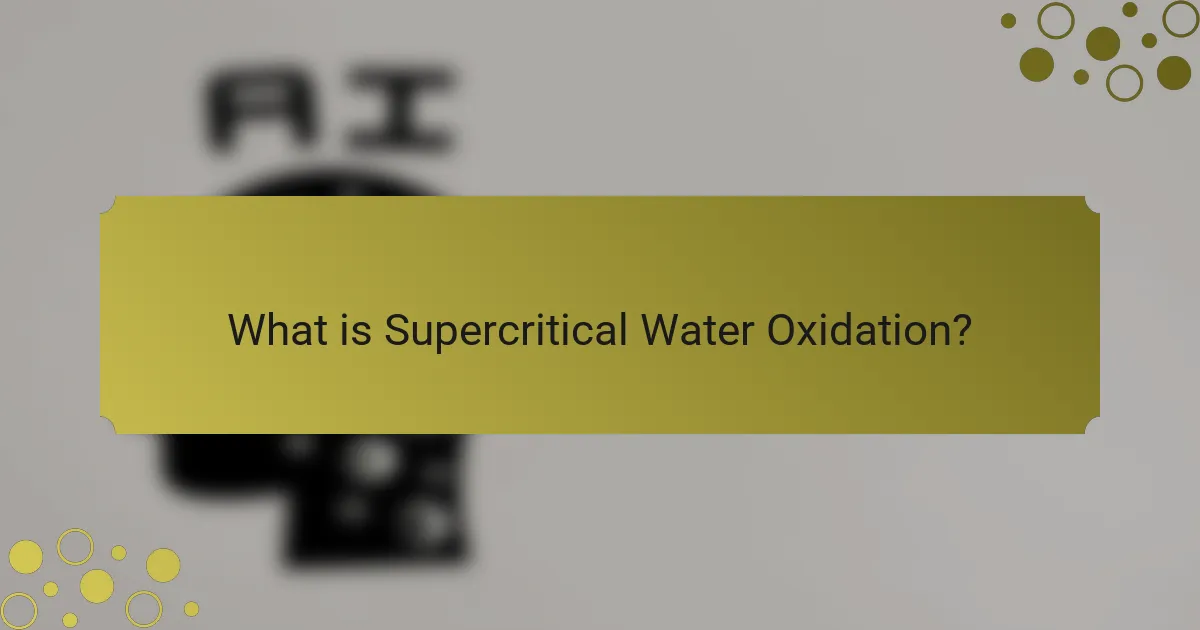
What is Supercritical Water Oxidation?
Supercritical Water Oxidation (SCWO) is a process that utilizes supercritical water as a solvent for the oxidation of organic materials. In this state, water exhibits unique properties that enhance the breakdown of waste. SCWO operates at high temperatures (typically above 374°C) and pressures (around 22 MPa). Under these conditions, water becomes supercritical, allowing for efficient reactions with organic compounds. The process results in the complete mineralization of waste, converting it into carbon dioxide, water, and inorganic residues. SCWO is effective for treating various types of waste, including hazardous and industrial waste. Studies have shown that SCWO can achieve high destruction efficiencies, often exceeding 99%.
How does Supercritical Water Oxidation function?
Supercritical Water Oxidation (SCWO) functions by oxidizing organic materials in water at high temperature and pressure. In this process, water reaches a supercritical state, where it exhibits unique solvent properties. The supercritical water allows for efficient dissolution of organic compounds. At temperatures above 374°C and pressures above 22.1 MPa, SCWO effectively breaks down hazardous waste. The oxidation reactions occur rapidly, resulting in the formation of carbon dioxide and water. This method minimizes the production of harmful byproducts. SCWO is particularly effective for treating industrial waste and sewage. Research indicates that SCWO can achieve over 99% destruction efficiency for organic pollutants.
What are the key characteristics of supercritical water?
Supercritical water is water at a temperature above 374 degrees Celsius and a pressure above 22.1 MPa. In this state, it exhibits unique properties. Supercritical water has a low density similar to gas and a high solvent capacity for organic compounds. Its dielectric constant is significantly reduced compared to liquid water. This allows for enhanced reaction rates and improved mass transfer. The solubility of gases in supercritical water is also higher than in liquid water. These characteristics enable efficient oxidation processes in waste treatment applications. Studies have shown that supercritical water can effectively break down complex organic materials.
What reactions occur during Supercritical Water Oxidation?
Supercritical Water Oxidation (SCWO) involves several key reactions. The primary reaction is the oxidation of organic matter in supercritical water. This occurs at high temperatures and pressures, typically above 374°C and 22.1 MPa.
In SCWO, organic compounds react with dissolved oxygen. This reaction produces carbon dioxide, water, and inorganic residues. The complete oxidation of hydrocarbons generates carbon dioxide and water vapor. Partial oxidation can yield intermediate products like carbon monoxide and organic acids.
The presence of supercritical water enhances reaction kinetics. This leads to higher reaction rates compared to conventional oxidation processes. Additionally, SCWO can effectively break down complex organic molecules, including hazardous waste.
Studies indicate that SCWO can achieve over 99% destruction efficiency for certain waste types. This efficiency is due to the unique properties of supercritical water, which acts as both a solvent and a reactant.
What are the primary benefits of Supercritical Water Oxidation?
Supercritical Water Oxidation (SCWO) offers several primary benefits. It effectively treats hazardous waste by converting it into non-toxic byproducts. The process operates at high temperatures and pressures, ensuring complete mineralization of organic compounds. SCWO minimizes the volume of waste, reducing disposal costs and environmental impact. The technology can handle a wide range of waste types, including industrial and municipal waste. Additionally, it produces energy in the form of heat, which can be harnessed for other applications. SCWO’s efficiency leads to lower greenhouse gas emissions compared to traditional incineration methods. Overall, SCWO is a sustainable solution for waste management and environmental protection.
How does Supercritical Water Oxidation contribute to waste reduction?
Supercritical Water Oxidation (SCWO) contributes to waste reduction by converting organic waste into harmless byproducts. SCWO operates at high temperature and pressure, allowing water to exist in a supercritical state. In this state, water becomes an effective solvent for organic compounds. The process oxidizes these compounds, breaking them down into carbon dioxide, water, and inorganic salts.
Studies show that SCWO can achieve waste reduction efficiencies exceeding 90%. This efficiency is crucial for managing hazardous and difficult-to-treat waste. SCWO minimizes the volume of waste requiring disposal and reduces the environmental impact associated with landfilling. The technology also recovers energy from the waste, further enhancing sustainability.
What environmental advantages does Supercritical Water Oxidation provide?
Supercritical Water Oxidation (SCWO) provides significant environmental advantages by effectively treating hazardous waste. It converts organic materials into harmless byproducts such as water and carbon dioxide. The process operates at high temperatures and pressures, ensuring complete oxidation of contaminants. This minimizes the release of toxic substances into the environment. SCWO also reduces the volume of waste, leading to less landfill use. Additionally, it can handle a wide range of waste types, including pharmaceuticals and industrial byproducts. Studies show that SCWO can achieve destruction efficiencies above 99%. This makes it a highly effective method for waste management while promoting environmental sustainability.
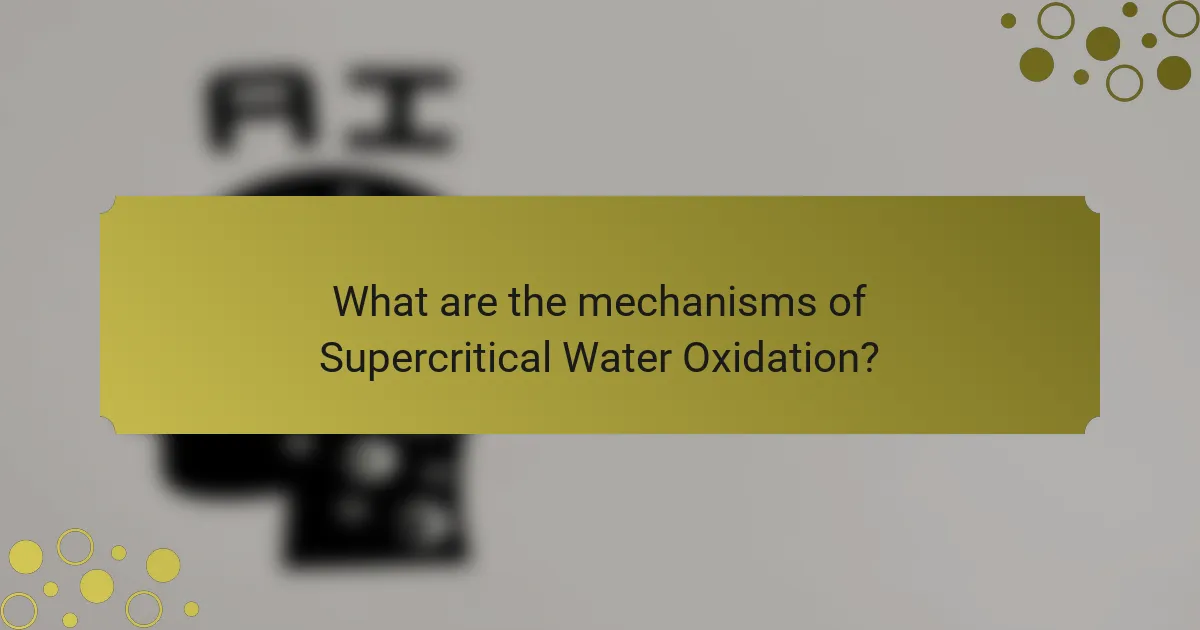
What are the mechanisms of Supercritical Water Oxidation?
Supercritical Water Oxidation (SCWO) mechanisms involve the oxidation of organic materials in supercritical water conditions. In SCWO, water is heated above its critical temperature of 374°C and pressure of 22.1 MPa. Under these conditions, water behaves as a solvent and reacts with organic compounds. The high temperature facilitates the breakdown of complex organic molecules into simpler compounds.
Oxygen or oxidizing agents are introduced to enhance the oxidation process. This results in the formation of carbon dioxide, water, and mineral salts as final products. The reaction kinetics in SCWO are influenced by factors such as temperature, pressure, and the concentration of reactants.
Research indicates that SCWO can effectively treat various types of waste, including hazardous and non-hazardous materials. Studies show that SCWO can achieve over 99% destruction of organic contaminants. This efficiency is due to the unique properties of supercritical water, which promotes rapid reactions.
What role do temperature and pressure play in Supercritical Water Oxidation?
Temperature and pressure are critical parameters in Supercritical Water Oxidation (SCWO). They determine the state of water, enabling it to act as a solvent for organic materials. Typically, temperatures above 374°C and pressures above 22.1 MPa are required to achieve supercritical conditions. Under these conditions, water exhibits unique properties, such as low dielectric constant and high diffusivity. These attributes enhance the oxidation reactions of organic compounds. Increased temperature accelerates reaction rates, while elevated pressure helps dissolve more organic materials. This combination leads to more efficient waste treatment and complete mineralization of hazardous substances. Studies show that optimal temperature and pressure can significantly improve the overall efficiency of SCWO processes.
How do variations in temperature affect the oxidation process?
Variations in temperature significantly affect the oxidation process. Higher temperatures generally increase the rate of oxidation reactions. This is due to the enhanced kinetic energy of molecules at elevated temperatures. Increased molecular motion leads to more frequent and effective collisions. For example, supercritical water oxidation operates optimally at temperatures above 374°C. At this temperature, water becomes a supercritical fluid, enhancing its solvent properties. This results in improved solubility of organic compounds, facilitating their oxidation. Studies show that reaction rates can double for every 10°C increase in temperature. Therefore, precise temperature control is crucial for efficient oxidation in supercritical water systems.
What impact does pressure have on reaction efficiency?
Pressure significantly impacts reaction efficiency in supercritical water oxidation. Increased pressure enhances the solubility of reactants in the supercritical fluid. This leads to a higher concentration of reactants, thereby increasing the reaction rate. Elevated pressure also raises the density of supercritical water, which can improve mass transfer between reactants. Studies indicate that optimal pressure ranges can maximize oxidation efficiency. For instance, research shows that pressures around 25 MPa can significantly reduce reaction times. This demonstrates that pressure is a critical factor in optimizing supercritical water oxidation processes.
How does Supercritical Water Oxidation compare to other waste treatment methods?
Supercritical Water Oxidation (SCWO) is a waste treatment method that effectively decomposes organic materials. It operates at high temperatures and pressures, allowing water to act as a solvent and oxidant simultaneously. This process results in the complete mineralization of waste into carbon dioxide and water. Compared to traditional methods like incineration and landfilling, SCWO produces less harmful emissions. Incineration often releases toxic gases, while landfilling can lead to leachate and methane production. SCWO also has a higher efficiency in treating hazardous and difficult-to-manage wastes. Studies indicate SCWO can achieve up to 99% destruction of organic contaminants. This efficiency makes it a superior option for treating complex waste streams.
What are the advantages of Supercritical Water Oxidation over incineration?
Supercritical Water Oxidation (SCWO) offers several advantages over incineration. SCWO operates at high temperatures and pressures, allowing for the complete oxidation of organic materials. This process minimizes the formation of harmful byproducts, unlike incineration, which can produce toxic emissions. SCWO also effectively treats a wider range of waste types, including hazardous and difficult-to-treat materials. The efficiency of SCWO leads to higher energy recovery compared to incineration. Additionally, SCWO generates less residual ash, reducing the need for landfill disposal. Studies show that SCWO can achieve destruction efficiencies exceeding 99%, ensuring thorough waste treatment. These factors make SCWO a more environmentally friendly and efficient alternative to traditional incineration methods.
How does Supercritical Water Oxidation differ from biological treatment processes?
Supercritical Water Oxidation (SCWO) differs from biological treatment processes primarily in its operational mechanism and efficiency. SCWO uses high temperature and pressure to oxidize organic waste in water, effectively breaking down contaminants into carbon dioxide and water. This process occurs rapidly, often within minutes, compared to biological treatments that can take days or weeks.
Biological treatment relies on microorganisms to degrade organic matter, which can be limited by environmental conditions and the type of waste. SCWO, on the other hand, is not dependent on biological activity and can treat a wider range of waste, including hazardous materials.
Additionally, SCWO operates in a closed system, minimizing emissions and allowing for energy recovery, while biological processes may produce odors and require extensive land area. The efficiency of SCWO in destroying pollutants is much higher, achieving over 99% destruction of organic compounds, while biological methods may leave residual contaminants.
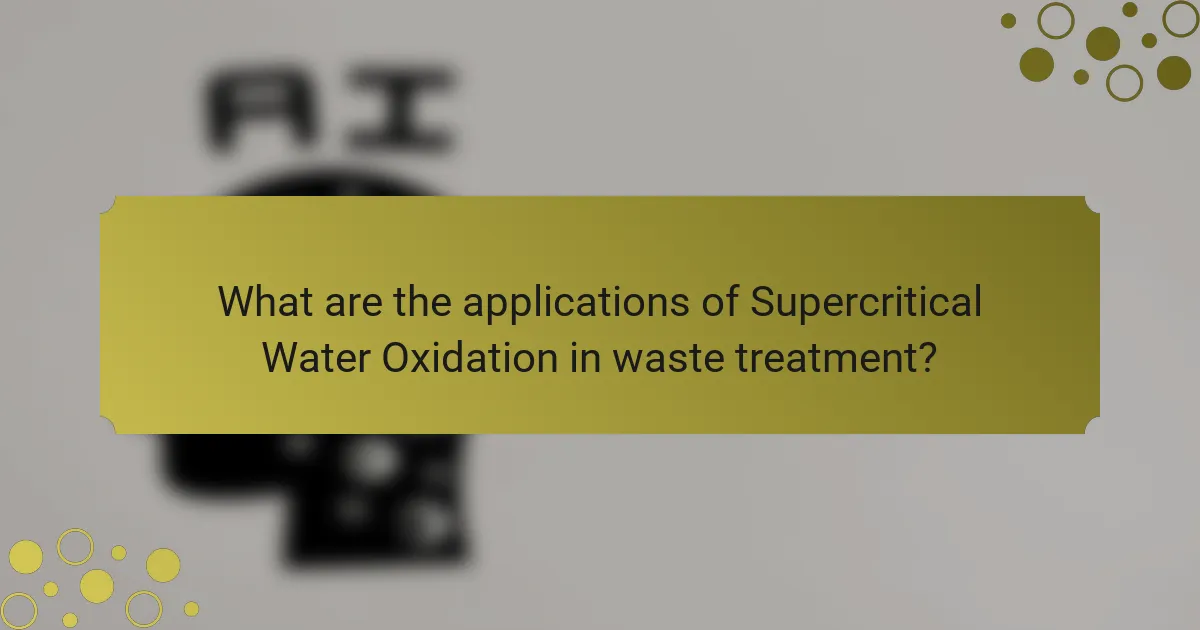
What are the applications of Supercritical Water Oxidation in waste treatment?
Supercritical Water Oxidation (SCWO) is used in waste treatment to effectively decompose organic pollutants. SCWO operates at high temperatures and pressures, enabling rapid oxidation of hazardous materials. This method is applicable for treating various types of waste, including industrial effluents and medical waste. SCWO can convert organic compounds into harmless byproducts like carbon dioxide and water. It significantly reduces the volume of waste, making disposal easier and more efficient. Studies show that SCWO can achieve over 99% destruction efficiency for many organic contaminants. This technology is particularly beneficial for treating wastewater that contains high concentrations of toxic substances. Additionally, SCWO can handle waste streams with varying compositions, making it versatile in waste management applications.
What types of waste can be treated using Supercritical Water Oxidation?
Supercritical Water Oxidation can treat various types of waste. This includes organic waste, hazardous waste, and industrial wastewater. It effectively handles medical waste and sewage sludge. Additionally, it can process contaminated soils and food waste. The technology breaks down complex organic compounds into simpler molecules. This process minimizes harmful emissions and produces less residual waste. Studies show it can achieve high destruction efficiencies for organic materials.
How effective is Supercritical Water Oxidation for hazardous waste treatment?
Supercritical Water Oxidation (SCWO) is highly effective for hazardous waste treatment. SCWO operates at high temperatures and pressures, allowing organic contaminants to be oxidized in water. This process converts hazardous waste into non-toxic byproducts, primarily carbon dioxide and water. Research shows that SCWO can achieve destruction efficiencies exceeding 99% for various organic pollutants. Studies indicate that SCWO is particularly effective for treating wastewater containing complex organic materials, such as pharmaceuticals and industrial waste. The technology minimizes the volume of waste and reduces the need for landfilling. Overall, SCWO represents a promising solution for the safe and efficient treatment of hazardous waste.
What role does Supercritical Water Oxidation play in the treatment of municipal waste?
Supercritical Water Oxidation (SCWO) plays a crucial role in the treatment of municipal waste. It effectively decomposes organic materials at high temperatures and pressures. In SCWO, water acts as a solvent and oxidant, facilitating the breakdown of waste. This process converts waste into harmless byproducts like carbon dioxide and water. SCWO can treat a variety of waste, including sludge and industrial effluents. The technology reduces waste volume significantly, making disposal easier. Research shows SCWO can achieve over 99% destruction efficiency for organic compounds. This efficiency supports environmental sustainability by minimizing landfill use and pollution.
How is Supercritical Water Oxidation implemented in industrial settings?
Supercritical Water Oxidation (SCWO) is implemented in industrial settings primarily for waste treatment. In this process, organic waste is mixed with water and heated above its critical temperature and pressure. This creates a supercritical state where water acts as both a solvent and an oxidant. The high temperature, typically around 374°C, and pressure, around 22.1 MPa, facilitate the oxidation of organic materials.
SCWO systems often include a feed system, a reactor, and a separation unit. The feed system injects waste and water into the reactor. The reactor is designed to withstand high pressure and temperature conditions. Upon entering the reactor, waste undergoes rapid oxidation, converting it into carbon dioxide, water, and inorganic residues.
The efficiency of SCWO is enhanced by using catalysts to speed up the reaction. Industrial applications have demonstrated SCWO’s effectiveness in treating various waste types, including pharmaceuticals and hazardous materials. Studies indicate that SCWO can reduce waste volume by up to 90%. This technology is increasingly adopted due to its ability to minimize environmental impact and produce energy from waste.
What are the key operational considerations for using Supercritical Water Oxidation?
Key operational considerations for using Supercritical Water Oxidation include temperature, pressure, and feedstock characteristics. The process typically operates at temperatures between 300°C and 700°C. Pressures must be maintained above 22.1 MPa to keep water in a supercritical state. Feedstock composition affects reaction kinetics and efficiency. The presence of salts and heavy metals can influence system performance. Additionally, reactor design must facilitate efficient mixing and heat transfer. Safety measures are essential due to high-pressure and high-temperature conditions. Regular maintenance is required to ensure optimal operation and prevent corrosion.
What technologies are integrated with Supercritical Water Oxidation systems?
Supercritical Water Oxidation (SCWO) systems integrate several technologies. These include heat exchangers for temperature regulation. They also utilize pumps for maintaining high pressure. Reaction vessels are essential for the oxidation process. Additionally, separation technologies are employed for product recovery. Gas treatment systems are integrated for emissions control. Monitoring systems ensure operational efficiency. Together, these technologies enhance the effectiveness of SCWO in waste treatment applications.
What best practices should be followed when utilizing Supercritical Water Oxidation?
Best practices for utilizing Supercritical Water Oxidation (SCWO) include careful control of temperature and pressure. Maintaining optimal conditions ensures efficient oxidation of organic materials. Regular monitoring of feed composition is crucial for process stability. This helps prevent operational issues and enhances treatment efficiency. Implementing proper safety protocols protects personnel from high-pressure systems. Routine maintenance of equipment minimizes downtime and ensures reliable operation. Additionally, utilizing advanced monitoring technologies aids in real-time process optimization. These practices collectively enhance the effectiveness and safety of SCWO systems.
Supercritical Water Oxidation (SCWO) is a waste treatment process that utilizes supercritical water to oxidize organic materials, effectively converting them into non-toxic byproducts such as carbon dioxide and water. The article explores the mechanisms of SCWO, highlighting its operational conditions of high temperature and pressure, and detailing its effectiveness in treating various types of waste, including hazardous and municipal waste. Key benefits of SCWO include high destruction efficiencies exceeding 99%, reduced environmental impact, and the ability to minimize waste volume. Additionally, the article discusses operational considerations, integration with other technologies, and best practices for implementing SCWO in industrial settings.
